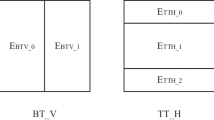Abstract
The high-efficiency video coding standard (HEVC) coding efficiency performance is mainly reached due to the recursive quad-tree coding unit mode decision tool. Nevertheless, this sophisticated module impact on enhancing coding efficiency came at the expense of noticeable computational complexity increase. To speed up the encoding process, an efficient fast coding unit (CU) decision algorithm based on fuzzy support vector machine (FSVM) is adopted in this paper. The purpose of this approach is to predict coding decision without RD cost calculation, which eliminates extensive computational time used to check all block decision candidates. An appropriate feature set is first selected to achieve excellent accuracy performance. Then, trained classifiers are incorporated into reference encoder and combined with fast mode decision algorithms to further improve the coding efficiency. Proposed model exhibits high classification accuracy in CU partitioning. Experimental results show a significant speedup in terms of encoding time reaching 70.57% with 0.22% compression efficiency improvement at the same objective video quality.









Similar content being viewed by others
References
Sullivan, G.J., Ohm, J.R., Han, W.-J., et al.: Overview of the high efficiency video coding (HEVC) standard. IEEE Trans. Circuits Syst. Video Technol. 22(12), 1649–1668 (2012)
Wiegand, T., Sullivan, G.J., Bjontegaard, G., et al.: Overview of the H. 264/AVC video coding standard. IEEE Trans. Circuits Syst. Video Technol. 13(7), 560–576 (2003)
Bossen, F., Bross, B., Suhring, K., et al.: HEVC complexity and implementation analysis. IEEE Trans. Circuits Syst. Video Technol. 22(12), 1685–1696 (2012)
Cebrian-Marquez, G., Martínez, J.L., Cuenca, P.: Adaptive inter CU partitioning based on a look-ahead stage for HEVC. Signal Process. Image Commun. 76, 97–108 (2019)
Wang, S., Luo, F., Ma, S., et al.: Low complexity encoder optimization for HEVC. J. Vis. Commun. Image Represent. 35, 120–131 (2016)
Xiong, J., Li, H., Wu, Q., et al.: A fast HEVC inter CU selection method based on pyramid motion divergence. IEEE Trans. Multimedia 16(2), 559–564 (2013)
Li, Y., Yang, G., Zhu, Y., et al.: Adaptive inter CU depth decision for HEVC using optimal selection model and encoding parameters. IEEE Trans. Broadcast. 63(3), 535–546 (2017)
Fernández, D.G., del Barrio, A.A., Botella, G., et al.: Fast and effective CU size decision based on spatial and temporal homogeneity detection. Multimed. Tools Applications 77(5), 5907–5927 (2018)
Lee, J.H., Goswami, K., Kim, B.G., et al.: Fast encoding algorithm for high-efficiency video coding (HEVC) system based on spatio-temporal correlation. J. Real-Time Image Processing 12(2), 407–418 (2016)
Shen, L., Zhang, Z., Liu, Z.: Adaptive inter-mode decision for HEVC jointly utilizing inter-level and spatiotemporal correlations. IEEE Trans. Circuits Syst. Video Technol. 24(10), 1709–1722 (2014)
Xu, M., Li, T., Wang, Z., et al.: Reducing complexity of HEVC: a deep learning approach. IEEE Trans. Image Process. 27(10), 5044–5059 (2018)
Zhu, L., Zhang, Y., Kwong, S., et al.: Fuzzy SVM-based coding unit decision in HEVC. IEEE Trans. Broadcast. 64(3), 681–694 (2017)
Bouaafia, S., Khemiri, R., Sayadi, F.E., et al.: Fast CU partition-based machine learning approach for reducing HEVC complexity. J. Real-Time Image Process. 17(1), 185–196 (2020)
Li, N., Zhang, Y., Zhu, L., et al.: Reinforcement learning based coding unit early termination algorithm for high efficiency video coding. J. Vis. Commun. Image Represent. 60, 276–286 (2019)
Yang, J., Kim, J., Won, K., et al.: Early SKIP Detection for HEVC, Document JCTVC-G543. JCT-VC, Geneva, Switzerland (2011)
Li, B., Xu, J., Wu, F., et al.: Redundancy reduction in CBF and Merging coding. In: Joint Collaborative Team on Video Coding (JCT-VC) of ITU-T SG16 WP3 and ISO/IEC JTC1/SC29/WG11 3rd Meeting. 2010. p. 1–8
Kiho, C., Sang-Hyo, P., Jang, E. S.: Coding tree pruning based CU early termination. Document JCTVC-F092, JCT-VC, Torino, 2011
Moraes, D., Wainer, J., Rocha, A.: Low false positive learning with support vector machines. J. Vis. Commun. Image Represent. 38, 340–350 (2016)
JCT-VC, HM software. https://hevc.hhi.fraunhofer.de/svn/svnHEVCSoftware/tags/HM-16.5/
SJTU 4K Video Sequences: http://medialab.sjtu.edu.cn/web4k/index.html
Author information
Authors and Affiliations
Additional information
Publisher's Note
Springer Nature remains neutral with regard to jurisdictional claims in published maps and institutional affiliations.
Rights and permissions
About this article
Cite this article
Werda, I., Maraoui, A., Belghith, F. et al. HEVC coding unit decision based on machine learning. SIViP 16, 1345–1353 (2022). https://doi.org/10.1007/s11760-021-02086-y
Received:
Revised:
Accepted:
Published:
Issue Date:
DOI: https://doi.org/10.1007/s11760-021-02086-y




